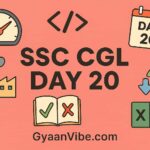GyaanVibe is a focused educational platform dedicated to helping SSC CGL aspirants crack Tier 1 & Tier 2 exam with a strategic, day-wise, and well-structured preparation approach.
SSC CGL Preparation – Day 10
Non-Verbal Reasoning – Puzzles
📘 What is Non-Verbal Reasoning (Puzzles)?
Non-Verbal Reasoning (NVR) puzzles involve visual and spatial reasoning using figures, images, patterns, or diagrams. Unlike verbal reasoning, it doesn’t involve language or numbers but focuses on logic and pattern recognition.
These are commonly asked in SSC exams to test your mental ability, visual memory, and spatial awareness.
🔍 Types of Non-Verbal Reasoning Puzzles
- Figure Matrix
- Series of Figures
- Classification/Odd One Out
- Mirror and Water Images
- Paper Folding and Cutting
- Embedded Figures
- Completion of Incomplete Pattern
- Cubes and Dice
✨ 1. Figure Matrix
A grid where each row/column follows a pattern. One figure is missing—you must choose the one that completes the pattern.
🔹 Example:
A 3×3 matrix where shapes rotate/multiply/change from left to right.
🔑 Tips:
- Focus on rotation, addition, subtraction of elements.
- Analyze movement, symmetry, size, number of elements.
✨ 2. Series of Figures
You are shown a sequence of figures that follow a specific pattern. You need to find the next figure.
🔹 Patterns can include:
- Rotation (clockwise/anticlockwise)
- Addition/removal of elements
- Changing shapes/symbols
- Alteration in shading
🔑 Tips:
- Look at directions, corners, lines, count of elements.
✨ 3. Classification (Odd One Out)
Choose the figure which is different from the rest.
🔑 Tips:
- Look at shape, size, angle, number of sides, orientation.
✨ 4. Mirror and Water Images
Determine how a figure looks in its mirror reflection (left-right) or water reflection (top-bottom).
🔑 Tips:
- In mirror image, left ↔ right
- In water image, top ↔ bottom
✨ 5. Paper Folding and Cutting
A paper is folded and then cut. You have to identify how it will look when unfolded.
🔑 Tips:
- Understand symmetry.
- Use logic: Cuts will mirror on folds.
✨ 6. Embedded Figures
Identify a simple figure hidden in a complex one.
🔑 Tips:
- Focus on lines, corners, and angles.
- Trace mentally; don’t get distracted by extra shapes.
✨ 7. Completion of Incomplete Pattern
A pattern or figure is partially given. You must choose the missing part that completes the figure.
🔑 Tips:
- Identify symmetry or repeating shapes.
- Focus on position, balance, and alignment.
✨ 8. Cubes and Dice
Visual reasoning involving unfolded cubes (net), dice with numbered faces, and coloring sides.
🔑 Tips:
- For cube nets: Opposite faces don’t appear together.
- Use spatial imagination for folding.
- Understand adjacent and opposite face rules.
📊 Weightage in SSC CGL
| Type | Expected Questions |
|---|---|
| Series Completion | 1–2 |
| Mirror/Water Image | 1 |
| Paper Folding/Cutting | 1 |
| Figure Matrix/Odd One Out | 1–2 |
| Embedded Figures/Patterns | 1 |
| Total (Approx.) | 5–6 Questions |
✅ Solved Examples
🔹 Example 1: Series
Q: Choose the next figure in the series:
⬜ ➡️ ◼️ ➡️ ⬜ ➡️ ◼️ ➡️ ?
Answer: ⬜
📘 Alternating white and black squares.
🔹 Example 2: Cube Folding
Q: A cube has 6 sides labeled A, B, C, D, E, F. A is opposite to D. If B is adjacent to A and C is adjacent to B, which side is opposite C?
Answer: E or F (depending on net diagram)
📘 Use elimination and folding logic.
💡 Smart Tricks to Solve NVR Puzzles
- Always count elements – lines, shapes, dots.
- Use rotation logic (90°, 180°, 270°).
- Apply symmetry – mirror or water logic.
- Practice with dice and cube nets regularly.
- Eliminate obvious wrong options first.
- Don’t overthink – most patterns are simple.
🏁 Conclusion
Non-Verbal Reasoning requires consistent visual practice. Don’t just read—solve puzzles daily. Focus on:
- Shape recognition
- Pattern logic
- Spatial imagination
With practice, you’ll build speed and accuracy—key to scoring well in the SSC exams.




